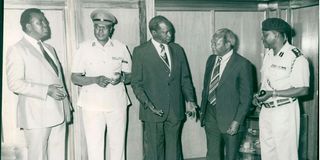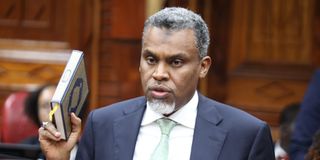Premium
James Kanyotu’s enduring legacy of secrecy and silence at Kenya’s spy agency

Then President Daniel Arap Moi (centre) pictured after a past Jogoo House meeting with the permanent secretary in the Office of the President, Mr Geoffrey Kariithi (second right); Maj. Gen. J.K. Mulinge (second left); Director of Intelligence Mr James Kanyotu (left) and Commissioner of Police Mr Benard Hinga.
Of all spymasters — now that we are looking to replace Maj-Gen Philip Kameru — none has been as opaque as James Kanyotu. Forget that Noordin Haji cleverly dodged the call to reveal to us his wealth by claiming that it will, at some point, become a national security issue, or that most of the holders of this office fade fast into oblivion.
It would be interesting if the surviving former spymasters — Wilson Boinett, Michael Gichangi and Kameru – could tell some bits of their stories to fill the voids of history rather than leave it to the David Talbots of this world.
Talbot did a thrilling book, The Devil’s Chessboard, on how CIA director Alen Dulles crafted the most powerful intelligence network on earth. But also, Dulles, after he retired, did The Craft of Intelligence, which is a historical look at the evolution of intelligence in the US. Africa's intelligence will be richer if we have perspectives from our own — and I rest my case.
The problem is that we have an intelligence system that seems beholden to ‘Kanyotuism’ – secrecy, silence, and sinisterism. Let me dissect the Three-S Syndrome or what I call “Kanyotuism”.
Tall and heavily built, Kanyotu was Kenya’s most elusive spy. Despite being a public figure, there are no newsroom photos of his early years as a detective.
Photographers never dared take his pictures, and no stories were filed about him. It was not worth the risk. That distorts history or simply leaves a blank space.
The much I have gleaned about Kanyotu was from the Kenya National Archives and these are obscure letters he could have written to third parties — either intimidating them or while forwarding his findings.
But we might need several years to tell the full story of Kenya’s dramatic history of intelligence, including how Kanyotu dealt with the Shifta — which included the setting up of the Eastern Station of Voice of Kenya — which always fascinates me.
In life, Mr Kanyotu was a law unto himself. He was the law. Most people got to see him when he appeared before the Goldenberg Commission in 2004 — after it emerged that he was the director of Goldenberg International and Exchange Bank, the two outfits set up by his Tigoni neighbour Kamlesh Pattni to steal billions of shillings from Treasury.
Smeared intelligence agency name
Kanyotu smeared the name of the intelligence agency and his explanation that he went there to collect intelligence was not convincing. Actually, the involvement of Mr Kanyotu in the Goldenberg heist, and as an active participant, had not only put the intelligence service to shame but revealed why it took so long before the matter became public.
And that is why Haji should have revealed his wealth to us (although I have heard some people say it doesn’t make a difference and that some officials exaggerated their wealth to cover anything they acquire in between!)

Nominee for Director General National Intelligence Service Noordin Haji before the National Assembly Departmental Committee on Defence, Intelligence and Foreign Relations at the County Hall for vetting.
Back to Kanyotu, he died a billionaire — richer than industrialists who were in manufacturing. For many years, he headed the spy unit – when it was known as Special Branch, and during the years, it operated like Germany’s Stasi, the Gestapo, or Hitler’s bodyguards, Schutzstaffel. In those days, the unit extracted information violently, and for the 27 years he reigned, the torture chambers and network of “safe houses” became sites of terror.
Mr Kanyotu spoke little and made limited public appearances. He never addressed any press conferences and set the code of silence exhibited by future intelligence officers. In his world, silence and myth meant power.
Dread defined the Directorate of Security Intelligence — renamed the National Security Intelligence Service and restructured it in 1999. The Special Branch — as it was previously known — was an arm of the Police Force, and its officers had the powers to arrest, interrogate, prosecute and make fatal mistakes in the form of EJK, as Haji called extra-judicial killings. Nyayo House was such a site.
Although he died before the Goldenberg cases were concluded, Mr Kanyotu told the Bosire Commission that he regretted the Goldenberg Affair. He had been charged in court alongside four others with conspiracy to steal Sh5.8 billion — unveiling a mask that he would have loved to go with to the grave.
Read Also: Uhuru shatters spy chiefs’ hopes
His palatial home in Tigoni, now a high-end hotel, was one of the feared addresses. Vehicles were not only barred from stopping by the gate — but any snooping would earn an arrest. When he was not playing golf, Mr Kanyotu would throw some restricted parties here — or at his other hidden palatial home in Nyandarua, right next to the Aberdare Forest. That this home, with a fine wood finish, was turned into a hotel without any modification of the decor shows that Mr Kanyotu had a taste for the good life. The property reflected his billionaire status.
An old boy of Alliance High School, Mr Kanyotu kept all the state secrets he held in the basement of this property, which had been redesigned to have high-tech communication equipment in times of war. It was typical of all intelligence chiefs.
Meeting before Mzee Kenyatta's death
Two weeks before Kenyatta died, Mr Kanyotu, privy to the health condition of the late President, held a meeting with then Vice-President Daniel arap Moi, Attorney-General Charles Njonjo, Head of Civil Service Geoffrey Kariithi and the paramilitary General Service Commandant Ben Gethi to plot the Kenyatta succession.
Intelligence reports had by then shown that Kenyatta might not live beyond December, and Mr Kanyotu was worried about power tussles by a group led by Mbiyu Koinange — who was always on Kenyatta’s side.
As a result, Mr Kanyotu would play a significant role in managing the Kenyatta transition — going by the order in which government officials were woken up early that morning of August 22, 1978. How I wish we do not hear these stories from third parties.
Another Kanyotu site was within Nyati House, next to Laico Regency in Nairobi. Even today, it is the little corner of mythical stories. A good friend of mine was once taken there when, as a first-year Political Science student, naïve and with the chutzpa of revolutionaries, he and his friends visited the Libyan Embassy overlooking Nyati House to borrow Gaddafi’s Green Book. Let me say the three boys were shaken.
Mr Kanyotu lived through the period when the assassinations of key politicians: Pio Gama Pinto, Tom Mboya, JM Kariuki and Robert Ouko were carried out.
During his tenure too, the Nyayo House torture chambers were constructed in 1983, with his team operating the 25th floor and the basement. The torture chambers marked one of the darkest blots in the Moi presidency.
The chambers epitomised the intolerance of the administration in the period between 1983 and 1992 when multi-party politics was reintroduced.
Mr Kanyotu’s men exclusively used the chambers, especially in the late 1980s, and survivors only lived to tell horrid tales of terror in the dark basement cells. A friend of mine, Mugo Theuri, has just released a book, Threads of Time, which captures his harrowing experience with the Kanyotu boys.
Mr Kanyotu ascended to the prestigious but challenging position of intelligence chief in January 1965 at the tender age of 28 to take over from Bernard Hinga, who had been named commissioner of police. He served for the entire period of the Kenyatta presidency and during the Moi reign until he retired in 1992 when multi-party democracy gained momentum.
Apart from his exploits in the intelligence world, Mr Kanyotu was a wealthy businessman with broad interests in the hotel industry, banking, aviation, real estate and large-scale farming. He owned the Sarova Hotels, which included The Stanley and Panafric hotels.
Mr Kanyotu’s departure from the helm of the intelligence agency in 1992 is reported to have had something to do with the Boxing Day 1991 resignation of the then Health minister Mwai Kibaki, who left government and Kanu to found the Democratic Party at the onset of multi-party politics.
It is reported that President Moi was unhappy that Kibaki’s resignation had caught him by surprise, and that his spymaster had not given prior information. But whether that was the reason or the excuse, Mr Kanyotu was a man who held more of Kenya’s intelligence history than any of the intelligence chiefs.
He was a master of loud silences.
[email protected] @johnkamau1





